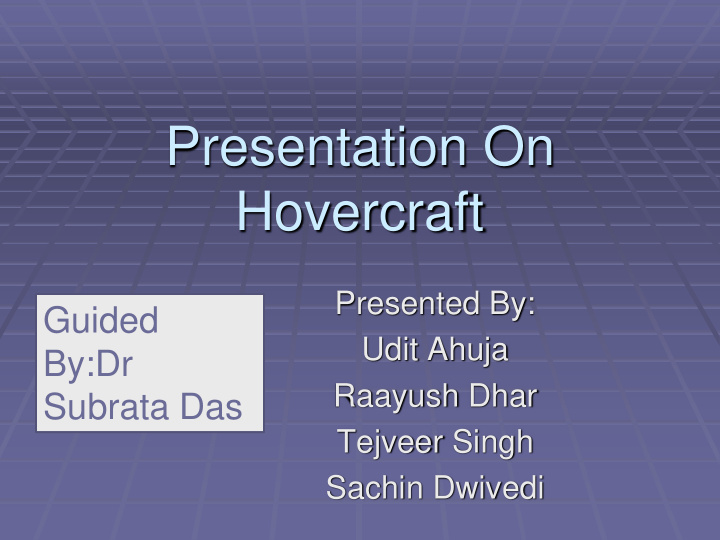



Presentation On Hovercraft Presented By: Guided Udit Ahuja By:Dr Raayush Dhar Subrata Das Tejveer Singh Sachin Dwivedi
Objectives Build a working, autonomous hovercraft Complete the course, even if it takes all the allotted time. Maximize maneuverability of the hovercraft Make the lightest and most cost efficient hovercraft possible
Basic components of hovercraft 1. Propellers 2. Air 3. Fan 4. Flexible skirt
Equipment List 2 sheets of core board 5 motors 1 switch 1 battery connecter 1 rudder kit 1 big motor 2 batteries Radio controller and receiver
Skirt and Body Assignments: Design and build a durable and lightweight body and skirt Find the best placement of parts Use cost efficient materials Create a leak free seal to the body of hovercraft
Design Process Decided to first build a prototype to test ideas on so that we don’t have to worry about perfect dimensions and appearance. Final version is the one where we carefully measured everything and used color coordinated materials.
Lift and Propulsion Assignments: Choose the adequate placement of fans Find powerful yet efficient fans to propel the hovercraft Find reversible fans Determine the best methods to power the fans
Structural Base
Skirt Design We considered an open, full, and tubular design. The tubular design was too complicated. The open design didn’t hold enough air in. We finally decided on a full skirt with holes to let some of the air out because it is simple and reliable.
Method of Sealing the Skirt
Number of Fans Originally, we considered having 2 fans. 1 down for lift and 1 backwards for thrust. Then, we thought about using each fan for both thrust and lift by dividing the air stream. We finally decided to use a larger motor for thrust and a fan for lift.
Our Wish List RCX Lexan (for the base material) Rubber (car inner tube or thin material for skirt) Battery Holder (for 8 double AA’s) 2 axial fans 1 lift fan Relays Zener Diodes (6) LED’s Wire
Thank you
Recommend
More recommend